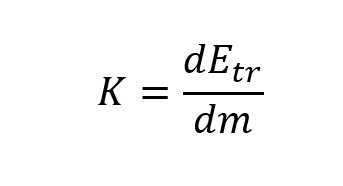Committed effective dose, E(τ)
The quantity 𝐸(𝜏), defined as:
![]()
![]()

where 𝐻T(𝜏) is the committed equivalent dose to tissue or organ T over the integration time 𝜏 elapsed after an intake of radioactive substances and 𝑤T is the tissue weighting factor for tissue or organ T. When 𝜏 is not specified, it will be taken to be 50 years for adults and the time to age 70 years for intakes by children.
Directional dose equivalent, H΄(d,Ω)
The dose equivalent that would be produced by the corresponding expanded field in the International Commission on Radiation Units and Measurements ICRU sphere at a depth d on a radius in a specified direction Ω.
- - Parameter defined at a point in a radiation field. Used as a directly measurable proxy (i.e. substitute) for equivalent dose in the skin for use in monitoring of external exposure.
- - The recommended value of "d" for weakly penetrating radiation is 0.07 mm
kerma, K
The quantity K, defined as:
![]()

where dEtr is the sum of the initial kinetic energies of all charged ionizing particles liberated by uncharged ionizing particles in a material of mass dm.
- - The SI unit for kerma is joule per kilogram (J/kg), termed the gray (Gy).
air kerma.
The kerma value for air.
- - Under charged particle equilibrium conditions, the air kerma (in grays) is numerically approximately equal to the absorbed dose in air (in grays).
reference air kerma rate.
The kerma rate to air, in air, at a reference distance of 1 m, corrected for air attenuation and scattering.
- - This quantity is expressed in μGy/h at 1 m.
Particle fluence, Φ.
A measure of the density of particles in a radiation field, defined as:
![]()

where dN is the number of particles incident on a sphere of cross-sectional area da.
Personal dose equivalent, Hp(d)
The dose equivalent in soft tissue below a specified point on the body at an appropriate depth d.
- - Parameter used as a directly measurable proxy (i.e. substitute) for equivalent dose in tissues or organs or (with d = 10 mm) for effective dose, in individual monitoring of external exposure.
- - The recommended values of "d" are 10 mm for strongly penetrating radiation and 0.07 mm for weakly penetrating radiation for whole body monitoring.
- - Hp(0.07) is used for monitoring for hands and feet for all radiation types.
- - Hp(3) is used for monitoring exposure of the lens of the eye.
-'Soft tissue' is commonly interpreted as the International Commission on Radiation Units and Measurements ICRU sphere.